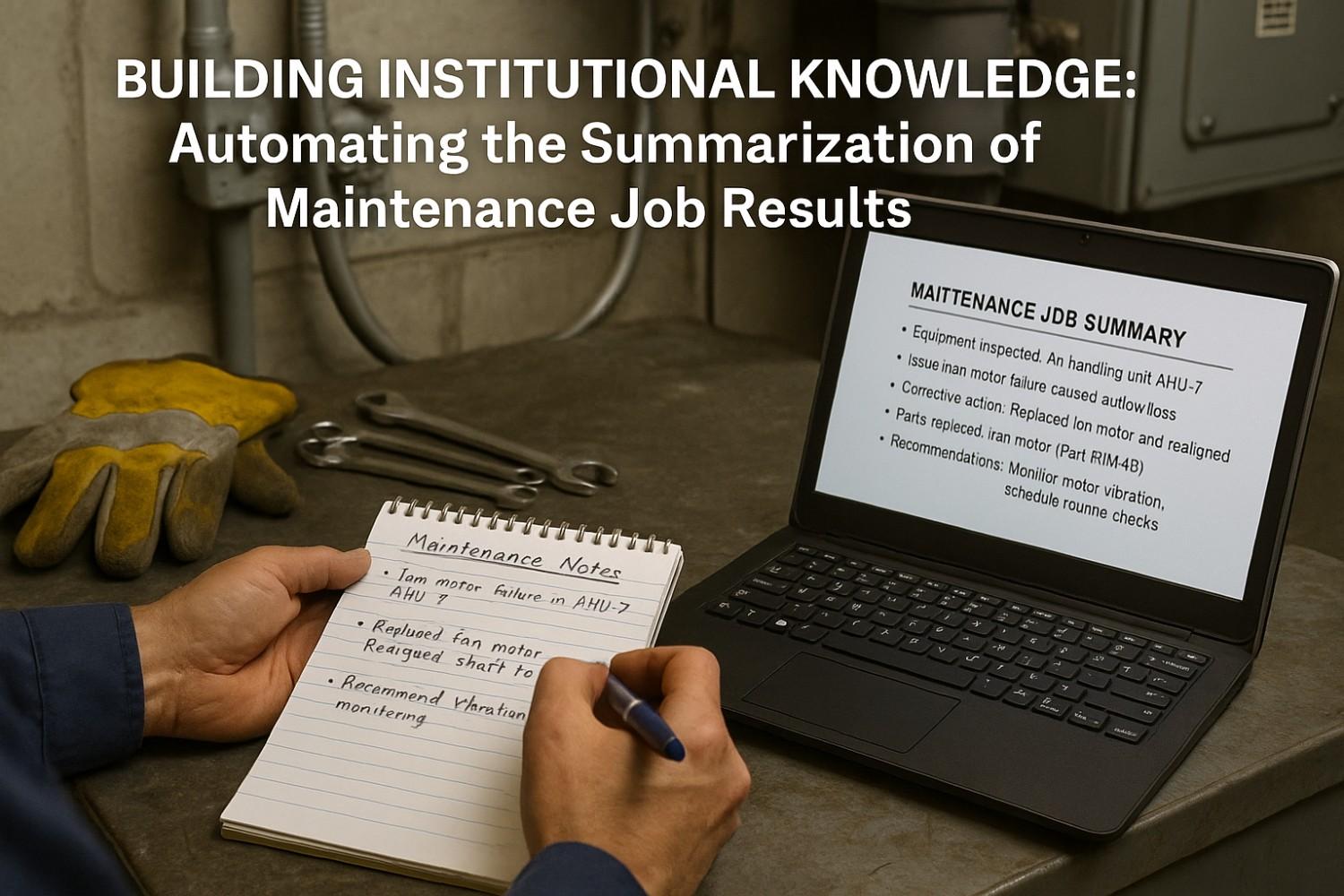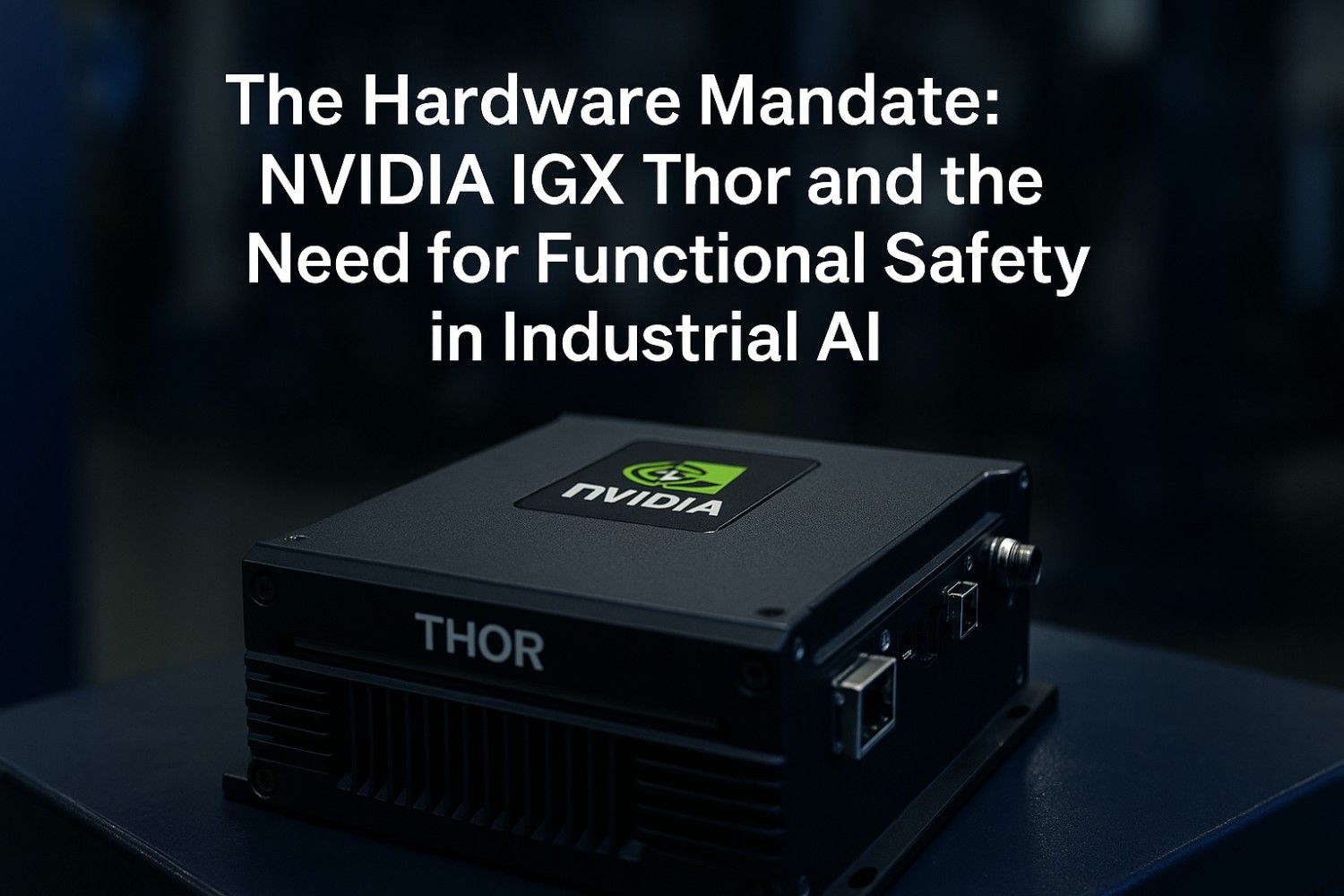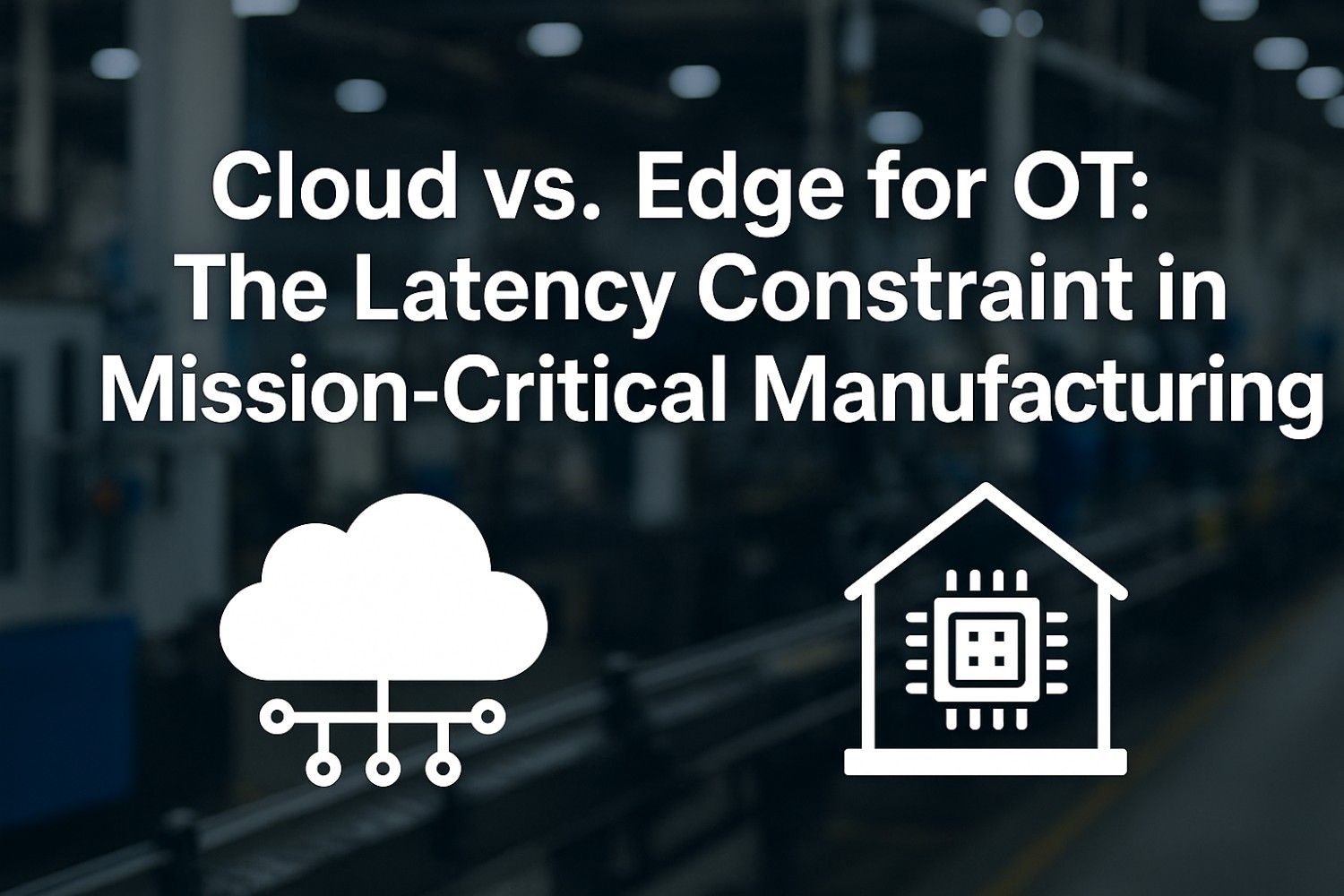Your data engineer stares at the screen at 3:42 AM debugging another failed AI deployment: "The LLM identified 'Sensor_A47_Temp' exceeding thresholds, but which equipment is that? Which production line? What's the normal operating range?" She scrolls through 847 disconnected sensor tags with cryptic names like "PLC3_AI_008" lacking any contextual relationship to physical assets, maintenance records, or operational significance. Your AI model processes numbers perfectly but understands nothing about what those numbers mean, where they originate, or how they relate to business processes documented in your ERP and CMMS systems. Without standardized data architecture bridging operational technology (OT) sensor streams with information technology (IT) business systems, your AI investment delivers algorithmic sophistication ,operating on meaningless data.
This integration crisis confronts American manufacturing facilities as operations attempt to layer AI analytics onto brownfield infrastructure never designed for cross-system data fusion. The average industrial facility operates 150-300 disparate data sources—PLCs, SCADA systems, historians, ERP platforms, CMMS databases—using incompatible protocols, inconsistent naming conventions, and isolated data silos preventing the contextual understanding AI systems require for meaningful analysis.
Facilities implementing standardized IT/OT data architectures using OPC UA and MQTT protocols achieve 60-80% reduction in AI deployment time while improving model accuracy by 40-60% through enriched contextual data. The transformation lies in establishing unified information models that connect raw sensor readings with equipment hierarchies, maintenance histories, production contexts, and business logic—creating AI-ready data foundations where every sensor value carries complete operational meaning.
Fix your data foundation before deploying AI—learn the OPC UA + MQTT standardization your team needs!
Raw sensor streams without contextual structure doom AI implementations to algorithmic sophistication processing meaningless data. Discover how OPC UA and MQTT protocols create unified information models connecting SCADA sensor readings with ERP asset hierarchies, CMMS maintenance histories, and production contexts. See the standardized data architecture that reduces AI deployment time by 60-80% while improving model accuracy by 40-60% through enriched contextual intelligence. Get actionable implementation strategies for brownfield systems in our technical workshop with downloadable integration blueprint.
Why Raw Sensor Data Needs Contextual Structure
Industrial sensor networks generate continuous streams of numeric measurements—temperatures, pressures, vibrations, flow rates—but these raw values contain zero inherent meaning without contextual frameworks linking measurements to physical assets, operational contexts, and business processes. A sensor reading "92.4°F" provides no actionable intelligence until connected with information identifying which equipment generated the reading, what normal operating range applies, how current conditions compare to historical patterns, and which maintenance procedures address deviations.
The semantic gap between raw sensor data and operational meaning creates fundamental barriers to AI deployment. Traditional SCADA systems organize data hierarchically by electrical topology—controllers, racks, modules, channels—rather than by functional equipment relationships or business logic. Sensor tag names like "PLC3_Rack2_Module4_Channel07" describe electrical wiring but reveal nothing about the compressor motor bearing those measurements monitor or the production line that equipment supports.
Missing Asset Context
Sensor tags lack connections to physical equipment identities, specifications, locations, and maintenance histories. AI models cannot determine which equipment generated anomalous readings or access relevant operational context for diagnosis.
Absent Hierarchical Relationships
No standardized representation of equipment belonging to lines, lines to zones, zones to facilities. AI cannot understand system interdependencies or cascade failure risks across connected equipment.
Disconnected Business Context
Sensor data isolated from ERP production schedules, CMMS maintenance records, quality system specifications. AI lacks operational intelligence explaining why measurements matter or how they impact business outcomes.
Inconsistent Naming Standards
Each system uses different asset naming conventions—SCADA tags differ from CMMS equipment IDs differ from ERP material codes. AI cannot correlate information across systems without manual mapping tables requiring constant maintenance.
Large Language Models require particularly rich contextual data because their strength lies in understanding relationships between entities rather than processing isolated numeric values. When maintenance logs reference "compressor #3" while sensor data uses "AIR_COMP_BLDG2_03" and ERP lists "COMP-2400-B2-3," the LLM cannot connect these references without standardized information models establishing equivalencies. Even worse, when sensor anomalies trigger without equipment context, AI-generated recommendations become generic rather than specific to equipment types, failure modes, and maintenance procedures.
OPC UA: The Essential Protocol for Data Hierarchy
OPC Unified Architecture (OPC UA) represents the industry-standard protocol specifically designed to address semantic gaps in industrial data through rich information models carrying contextual meaning alongside raw values. Unlike legacy OPC DA (Data Access) protocols transmitting only numeric measurements, OPC UA provides comprehensive object-oriented frameworks describing equipment hierarchies, data type definitions, relationships between entities, and metadata explaining what measurements represent within operational contexts.
The fundamental innovation in OPC UA involves information modeling—standardized methods for describing industrial equipment, processes, and data using hierarchical type systems similar to object-oriented programming. Equipment types inherit properties from parent classes while adding specialized characteristics. A "Pump" inherits common rotating equipment attributes while defining pump-specific properties like flow rate and discharge pressure. This type system enables AI models to understand equipment categories, apply appropriate analysis methods, and leverage domain knowledge without custom programming for every asset variant.
| OPC UA Capability | Technical Implementation | AI Benefit |
|---|---|---|
| Information Modeling | Object-oriented type systems with inheritance and composition | LLMs understand equipment categories and apply appropriate reasoning |
| Hierarchical Address Space | Tree structures organizing assets by facility, line, zone, equipment | AI identifies system relationships and cascade failure risks |
| Semantic Metadata | Engineering units, measurement ranges, update frequencies, quality indicators | Models validate data quality and interpret measurements correctly |
| Relationship Definition | Standardized references between related objects and data points | AI correlates sensor readings with equipment specs and maintenance history |
| Historical Access | Integrated time-series retrieval with metadata preservation | Models analyze trends with full contextual understanding maintained |
OPC UA companion specifications extend base architecture with domain-specific information models for particular industries and equipment types. The EUROMAP 83 specification defines standard models for plastic injection molding machines. ISA-95 integration models connect manufacturing operations with business systems. PackML standardizes packaging equipment control and data. These companion specs provide ready-made information models reducing implementation effort while ensuring consistency across vendors and facilities.
Security architecture represents another critical OPC UA advantage over legacy industrial protocols. Built-in authentication, authorization, encryption, and auditing capabilities enable secure data access without VPNs or proprietary security layers. Certificate-based authentication ensures only authorized systems access industrial data. Encrypted communications protect sensitive operational information during transmission. Granular permissions control which users and applications can read or modify specific data points. These security features prove essential when AI systems require cross-facility data access for federated learning or multi-site optimization.
MQTT and Sparkplug B: Efficient Data Transport
Message Queuing Telemetry Transport (MQTT) provides lightweight publish-subscribe messaging protocols optimized for industrial IoT deployments where bandwidth constraints, unreliable networks, and power limitations demand efficient data transport. Unlike request-response protocols requiring continuous polling, MQTT's publish-subscribe model enables edge devices to push data only when changes occur, dramatically reducing network traffic while ensuring applications receive updates immediately rather than waiting for poll cycles.
The publish-subscribe architecture decouples data producers from consumers through message brokers managing subscriptions and delivery. Sensors and PLCs publish data to specific topics without knowledge of consuming applications. AI analytics platforms, historians, and dashboards subscribe to relevant topics receiving automatic updates. This loose coupling simplifies system evolution—adding new analytics capabilities requires only subscribing to existing data topics without modifying edge devices or impacting other consumers.
MQTT/Sparkplug B Implementation Architecture
Sparkplug B extends basic MQTT with industrial-specific standardization addressing common integration challenges. The specification defines topic namespace structures organizing data hierarchically by enterprise, site, area, line, and device. Standardized payload formats using Google Protocol Buffers ensure efficient serialization while maintaining human readability. Birth and death certificates provide automatic device discovery and state management. Metric definitions embedded in birth certificates document engineering units, data types, and metadata eliminating ambiguity about measurement meaning.
MQTT/Sparkplug B Advantages for AI Deployment
- Report-by-exception reduces network traffic by 80-95% compared to polling, enabling real-time AI analysis without overwhelming networks
- Quality of Service levels guarantee message delivery for critical data while allowing best-effort transport for less important metrics
- Retained messages provide "last known good" values for AI models connecting to systems without requiring historical database queries
- Topic wildcards enable flexible subscriptions—AI platforms can subscribe to all temperature sensors across facilities using single subscription
- Binary payloads reduce message sizes by 60-80% compared to JSON, critical for bandwidth-constrained edge deployments
- Automatic reconnection and message queuing handle network disruptions without data loss, ensuring AI models receive complete datasets
- Edge computing integration allows local AI inference at remote sites with intermittent connectivity to central systems
- Horizontal scaling supports millions of concurrent connections through broker clustering, enabling facility-wide or enterprise-wide AI deployments
The combination of MQTT transport efficiency with OPC UA information richness creates optimal architectures for AI-ready data pipelines. Edge devices use MQTT/Sparkplug B for efficient data collection and local transport. Gateway systems translate Sparkplug B into OPC UA information models adding hierarchical organization and semantic metadata. AI platforms consume data through OPC UA interfaces benefiting from both efficient transport and rich contextual information. This layered architecture enables brownfield integration while providing greenfield-quality data structures.
IT/OT Convergence for Brownfield Systems
Brownfield manufacturing facilities face unique integration challenges connecting decades-old operational technology with modern information systems and AI platforms. Legacy PLCs, proprietary SCADA systems, and isolated historians use incompatible protocols, lack modern connectivity options, and cannot support direct AI integration without extensive infrastructure upgrades. Effective IT/OT convergence strategies must extract value from existing investments while establishing pathways toward standardized data architectures supporting AI deployment.
Protocol translation represents the most common brownfield integration pattern, deploying gateway systems that communicate with legacy equipment using native protocols while exposing data through modern standards like OPC UA and MQTT. These gateways handle the complexity of proprietary protocols—Modbus, Profibus, EtherNet/IP, vendor-specific interfaces—presenting unified OPC UA interfaces to consuming applications. Gateway-based architectures enable AI deployment without replacing functional equipment or disrupting production systems.
Brownfield Integration Strategies
- Protocol gateways translating legacy communications (Modbus, Profibus, proprietary) into OPC UA with information model enrichment
- Edge historians capturing high-frequency data locally while aggregating intelligently for efficient upstream transmission
- Unified namespace implementations creating virtual hierarchies organizing disparate data sources into consistent structures
- Database connectors extracting context from ERP and CMMS systems to enrich sensor data with equipment hierarchies and maintenance histories
- Time-series synchronization ensuring sensor readings align temporally with events documented in business systems
- Data quality validation detecting sensor failures, communication errors, and invalid values before AI processing
- Phased migration strategies beginning with high-value equipment while maintaining existing systems during transition periods
- Cloud-edge hybrid architectures supporting both on-premise AI processing and centralized analytics platforms
Unified namespace architectures provide particularly powerful approaches to brownfield integration by creating virtual information models that abstract away underlying system complexity. Rather than requiring AI platforms to understand hundreds of different data sources and protocols, unified namespaces present single, consistent hierarchies organizing all facility data regardless of origin. Equipment in the unified namespace carries complete context—sensor readings, specifications, maintenance history, production schedule-assembled from multiple systems but presented as coherent objects.
Data quality management becomes critical in brownfield environments where sensor failures, communication disruptions, and configuration errors inject bad data into AI pipelines. Validation layers detect implausible values, identify sensors producing constant readings indicating failures, flag communication errors requiring data interpolation, and score data quality enabling AI models to weight confidence appropriately. Without systematic quality management, brownfield data corruption causes AI models to learn from errors rather than actual equipment behavior.
Security considerations for IT/OT convergence require particular attention as gateway systems create potential paths for cyber threats to traverse between enterprise networks and industrial control systems. Proper architectures implement demilitarized zones (DMZs) isolating gateways from both sides, enforce unidirectional data flows from OT to IT where appropriate, employ deep packet inspection validating all communications, and maintain separate authentication systems preventing enterprise credential compromise from affecting operational systems. Modern OPC UA gateways provide built-in security features addressing these requirements.
Standardizing Asset Names and Work Order Codes
Consistent naming conventions and coding standards represent foundational requirements for AI-ready data architectures, yet most facilities operate with organic naming schemes that evolved over decades without central coordination. SCADA engineers name sensors based on electrical topology. Maintenance teams identify equipment using physical locations. ERP systems assign material codes following procurement logic. These inconsistent naming schemes prevent AI systems from correlating information across sources without extensive manual mapping requiring constant maintenance as facilities evolve.
Effective standardization establishes naming hierarchies that encode operational meaning directly in identifiers while maintaining consistency across all systems. The ISA-95 standard provides proven frameworks for equipment hierarchy naming based on enterprise, site, area, production line, work cell, and equipment unit levels. Asset names constructed following these hierarchies become self-documenting—"ENTERPRISE1.SITE2.AREA3.LINE4.COMP5" immediately communicates that this compressor belongs to production line 4 in area 3 of site 2 without consulting external documentation.
Asset Naming and Coding Standardization Framework
- Hierarchical naming following ISA-95 structures: Enterprise > Site > Area > Line > Cell > Unit with consistent delimiter conventions
- Equipment type codes using standard taxonomies (UNSPSC, eCl@ss) enabling AI models to recognize equipment categories automatically
- Functional location codes identifying physical placement independent of equipment identity for maintenance territory management
- Work order type classifications standardizing maintenance categories (preventive, predictive, corrective, project) across CMMS platforms
- Failure mode taxonomies using RCM or ISO 14224 codes enabling AI to correlate similar failures across different assets
- Priority and criticality scoring systems standardized across facilities allowing AI to appropriately weight equipment importance
- Measurement point naming that includes equipment context, measured parameter, and engineering unit in standard format
- Cross-reference mapping tables linking legacy names to standardized identifiers during transition periods
Work order coding standardization proves equally critical as maintenance documentation provides essential training data for AI systems learning to correlate sensor patterns with failure modes and optimal maintenance responses. Standardized work order types, priority classifications, failure codes, and corrective action categories enable AI to build generalizable models rather than learning facility-specific conventions. When one facility codes bearing failures as "BRG_FAIL" while another uses "BEARING_DEFECT" and a third employs numeric code "142," AI cannot leverage experience across facilities without standardization.
Implementation strategies must balance standardization benefits against disruption and migration costs. Phased approaches begin by standardizing new equipment and work orders while gradually migrating high-value legacy assets. Bi-directional mapping tables maintain compatibility during transitions, translating between legacy and standardized naming for systems not yet migrated. Modern CMMS platforms and OPC UA servers support aliasing where multiple names reference the same underlying object, enabling gradual standardization without big-bang migrations.
Conclusion
Industrial AI deployment success depends fundamentally on data architecture quality rather than algorithm sophistication. Raw sensor streams lacking contextual structure doom AI implementations to processing meaningless numbers without understanding equipment identities, operational relationships, or business significance. Facilities attempting to layer AI analytics onto brownfield infrastructure without addressing semantic gaps achieve only 30-40% of potential accuracy while consuming 70-80% of implementation effort on data preparation rather than model development.
OPC UA provides essential protocol architecture for semantic richness through information modeling, hierarchical address spaces, metadata embedding, and relationship definitions that transform isolated sensor values into contextually-rich operational intelligence. Object-oriented type systems enable AI models to understand equipment categories and apply appropriate reasoning without custom programming for every asset variant. Companion specifications provide domain-specific information models reducing implementation effort while ensuring cross-vendor consistency.
MQTT and Sparkplug B deliver efficient data transport optimized for industrial IoT constraints through publish-subscribe messaging, report-by-exception updates, quality of service guarantees, and standardized topic namespaces. The combination of MQTT transport efficiency with OPC UA information richness creates optimal architectures delivering AI-ready data pipelines from brownfield systems in 4-8 week implementations with 80-95% reduction in network overhead compared to polling protocols.
Brownfield IT/OT convergence strategies extract value from existing investments through protocol translation gateways, unified namespace implementations, and data quality validation layers. Gateway-based architectures communicate with legacy equipment using native protocols while exposing unified OPC UA interfaces to AI platforms. Proper security architectures isolate industrial control systems through DMZs, enforce unidirectional data flows where appropriate, and leverage OPC UA built-in security features protecting operational systems during IT integration.
Naming standardization and work order coding consistency eliminate manual mapping overhead while enabling AI models to transfer learning across facilities. ISA-95 hierarchical naming encodes operational meaning directly in identifiers. Equipment type taxonomies using UNSPSC or eCl@ss standards allow automatic category recognition. Standardized failure mode coding and maintenance classification systems provide essential structure for AI training data. Phased implementation with bi-directional mapping enables gradual standardization without disruptive big-bang migrations.
The data foundation determines AI success more than algorithm selection. Organizations investing in proper OPC UA and MQTT architectures, systematic naming standardization, and comprehensive IT/OT integration achieve faster deployment, higher accuracy, and better ROI than those attempting to compensate for poor data quality through complex algorithms. The path to successful industrial AI begins with fixing the data foundation.
Master the data foundation for industrial AI—learn OPC UA, MQTT, and IT/OT convergence patterns your team needs!
Join Oxmaint Inc. for an interactive technical workshop demonstrating complete IT/OT convergence implementation from brownfield SCADA and ERP systems to AI-ready data architecture. Watch live demonstrations of OPC UA information modeling, MQTT/Sparkplug B integration, protocol gateway deployment, unified namespace creation, and systematic naming standardization. Learn the proven patterns that reduce AI deployment time by 60-80% while improving model accuracy by 40-60% through enriched contextual data.
Perfect for IT/OT engineers, system integrators, data architects, and manufacturing technology leaders preparing facilities for AI deployment. Download free implementation blueprint with proven architecture patterns and migration frameworks.







.jpeg)

